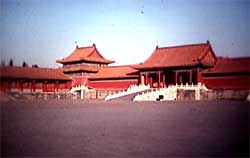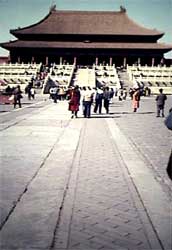|

Forbidden city (winter of 1995)
Many of you have seen the Hollywood movie called "The Last
Emperor." If
you have seen that movie, you probably remember the child running through a huge
palace. That child is known as Puyi, the last
emperor of the Qing Dynasy and the last person to live in the Imperial
Palace, otherwise known as the Forbidden City. The name "Forbidden
City " came from the fact that ordinary things (people or materials) could
not enter the gates, they were "forbidden."
When I first entered
the Forbidden City in the winter of 1995, I felt overwhelmed by the apparent immense size of
the palace. The height of the red walls surrounding the palace are almost
6 people tall . Since people outside the wall cannot
see what is inside, except for the top of a few buildings, it makes one curious
about what's going on inside the walls.
Surrounding the walls on the
outside is a moat. It separates the palace from outsiders and makes the palace a
highly secure place. There are only four bridges that cross the moat to
four gates: the Meredian Gate, Spiritual Valor Gate, Xihua (West) Gate, and the Donghua
(East) Gate. The Meridian Gate is just past the Tiananmen Gate, which is
across from Tiananmen Square. It is the front and main entrance into the
palace. The back entrance to the palace is the Gate of Spiritual Valor.
 I came in the main entrance, via the Tiananmen and Meridian Gate. The
Meridian Gate is where the emperor would give New Year's announcements as well
as determine the destiny of prisoners. Once inside the Meridian Gate,
there are several bridges, the Golden River bridges, that are surrounded by huge walls
with three gates. The gates are to the left and right with the Gate of Supreme
Harmony located directly in front. Once you pass through the Gate of Supreme
Harmony, you will be amazed by the size of the Hall of Supreme Harmony. This
Hall is over 110 feet tall and has golden-yellow tiles, a color only allowed for
emperors, on the roof. It is also known as the Throne Hall
because of all the important functions and ceremonies that took place
inside. In the movie, "The Last Emperor," this Hall is where the
ceremony took place when child, Puyi, became emperor. I came in the main entrance, via the Tiananmen and Meridian Gate. The
Meridian Gate is where the emperor would give New Year's announcements as well
as determine the destiny of prisoners. Once inside the Meridian Gate,
there are several bridges, the Golden River bridges, that are surrounded by huge walls
with three gates. The gates are to the left and right with the Gate of Supreme
Harmony located directly in front. Once you pass through the Gate of Supreme
Harmony, you will be amazed by the size of the Hall of Supreme Harmony. This
Hall is over 110 feet tall and has golden-yellow tiles, a color only allowed for
emperors, on the roof. It is also known as the Throne Hall
because of all the important functions and ceremonies that took place
inside. In the movie, "The Last Emperor," this Hall is where the
ceremony took place when child, Puyi, became emperor.
 While I was
standing there in the strong wind, I thought about all the history that took
place in the Hall. The Imperial Palace began with the Yuan Dynasty,
survived through the Ming, and ended with the Qing Dynasty, a span of almost 700
years. The history of the Palace is also Beijing's political history as
the capital of China.
While I was
standing there in the strong wind, I thought about all the history that took
place in the Hall. The Imperial Palace began with the Yuan Dynasty,
survived through the Ming, and ended with the Qing Dynasty, a span of almost 700
years. The history of the Palace is also Beijing's political history as
the capital of China.
To get to the Hall of Supreme Harmony, I walked on large stone tiles and saw
many cranes and tortoises symbolizing long life in front of the
Hall. Inside the building are many symbolic items, such as the 24
columns that are symbolic of the hours in a day. The six columns that
support that platform for the throne are decorated with the imperial
dragon. The throne's platform is impressive with its size, 6 feet tall and
the ceilings within are stunning with their beautiful decorations. It
reminded me of the power the emperors had and I envisioned them sitting their
attending their ceremonies with dignitaries.
Behind the Hall of Supreme Harmony is the Hall of Middle Harmony. This
is where the emperor met with officials and mingled while dealing with political
issues.
The Hall of Preserving Harmony is the next building and it is a banquet
hall. It is where the emperor would hold his banquets. Behind the
Hall, there is beautiful dragon pavement that goes down the center stairs from
the terrace.
At this point, I've seen almost half of the main buildings in the
Palace. After passing through the Gate of Heavenly Purity, I reach the
Palace of Heavenly Purity. This is where the the emperors lived during the
Ming period and where they studied during the latter part of the Qing dynasty.
The small Palace of Union between Heaven and Earth is where birthday
celebrations took place during the Qing Dynasty as well as the coronation of the
empresses. Behind this Palace is the Palace of Earthly Tranquility, and as
the name implies it was where the empresses resided. The bridal chamber is
located here and is where the emperors spent their wedding night with their
empresses.
I have now come to the Imperial Garden. All throughout the palace I
felt awed and alone surrounded by the immense buildings, and the spaciousness
with unending stone pavement. Entering the Imperial Garden was like
stepping into another world. Without the incessant wind blowing, it was
very tranquil and warm. There was green, unlike the gray of the pavement, with
varying shapes of trees, beautiful artificial stones, and a small
waterfall, all of which made me feel very peaceful. I was relaxed here and
spent a long time walking around the garden.
It's now time to leave, being here was quite an experience. I am glad I
came to one of the largest and most significant complexes in China, the Imperial
Palace. I admire those who worked on these buildings, they are works of
art. Fine detailing is seen everywhere and it is obvious the incredible
effort that went into building it. Those that worked on the Imperial
Palace, probably built it just for the emperor. The palace is now standing, no
longer for the emperors, but for those who had at one time been "forbidden."
AsianInfo.org Editor
K.Lee
|